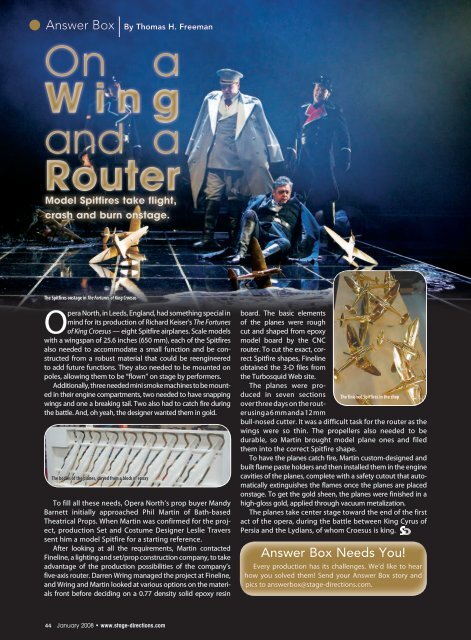Download a PDF - Stage Directions Magazine
Download a PDF - Stage Directions Magazine
Download a PDF - Stage Directions Magazine
Create successful ePaper yourself
Turn your PDF publications into a flip-book with our unique Google optimized e-Paper software.
Answer Box<br />
By Thomas H. Freeman<br />
On<br />
a<br />
Wing<br />
and a<br />
Router<br />
Model Spitfires take flight,<br />
crash and burn onstage.<br />
The Spitfires onstage in The Fortunes of King Croesus<br />
Opera North, in Leeds, England, had something special in<br />
mind for its production of Richard Keiser’s The Fortunes<br />
of King Croesus — eight Spitfire airplanes. Scale models<br />
with a wingspan of 25.6 inches (650 mm), each of the Spitfires<br />
also needed to accommodate a small function and be constructed<br />
from a robust material that could be reengineered<br />
to add future functions. They also needed to be mounted on<br />
poles, allowing them to be “flown” on stage by performers.<br />
Additionally, three needed mini smoke machines to be mounted<br />
in their engine compartments, two needed to have snapping<br />
wings and one a breaking tail. Two also had to catch fire during<br />
the battle. And, oh yeah, the designer wanted them in gold.<br />
The bodies of the planes, carved from a block of epoxy<br />
To fill all these needs, Opera North’s prop buyer Mandy<br />
Barnett initially approached Phil Martin of Bath-based<br />
Theatrical Props. When Martin was confirmed for the project,<br />
production Set and Costume Designer Leslie Travers<br />
sent him a model Spitfire for a starting reference.<br />
After looking at all the requirements, Martin contacted<br />
Fineline, a lighting and set/prop construction company, to take<br />
advantage of the production possibilities of the company’s<br />
five-axis router. Darren Wring managed the project at Fineline,<br />
and Wring and Martin looked at various options on the materials<br />
front before deciding on a 0.77 density solid epoxy resin<br />
board. The basic elements<br />
of the planes were rough<br />
cut and shaped from epoxy<br />
model board by the CNC<br />
router. To cut the exact, correct<br />
Spitfire shapes, Fineline<br />
obtained the 3-D files from<br />
the Turbosquid Web site.<br />
The planes were produced<br />
in seven sections The finished Spitfires in the shop<br />
over three days on the router<br />
using a 6 mm and a 12 mm<br />
bull-nosed cutter. It was a difficult task for the router as the<br />
wings were so thin. The propellers also needed to be<br />
durable, so Martin brought model plane ones and filed<br />
them into the correct Spitfire shape.<br />
To have the planes catch fire, Martin custom-designed and<br />
built flame paste holders and then installed them in the engine<br />
cavities of the planes, complete with a safety cutout that automatically<br />
extinguishes the flames once the planes are placed<br />
onstage. To get the gold sheen, the planes were finished in a<br />
high-gloss gold, applied through vacuum metalization.<br />
The planes take center stage toward the end of the first<br />
act of the opera, during the battle between King Cyrus of<br />
Persia and the Lydians, of whom Croesus is king.<br />
Answer Box Needs You!<br />
Every production has its challenges. We’d like to hear<br />
how you solved them! Send your Answer Box story and<br />
pics to answerbox@stage-directions.com.<br />
44 January 2008 • www.stage-directions.com

















